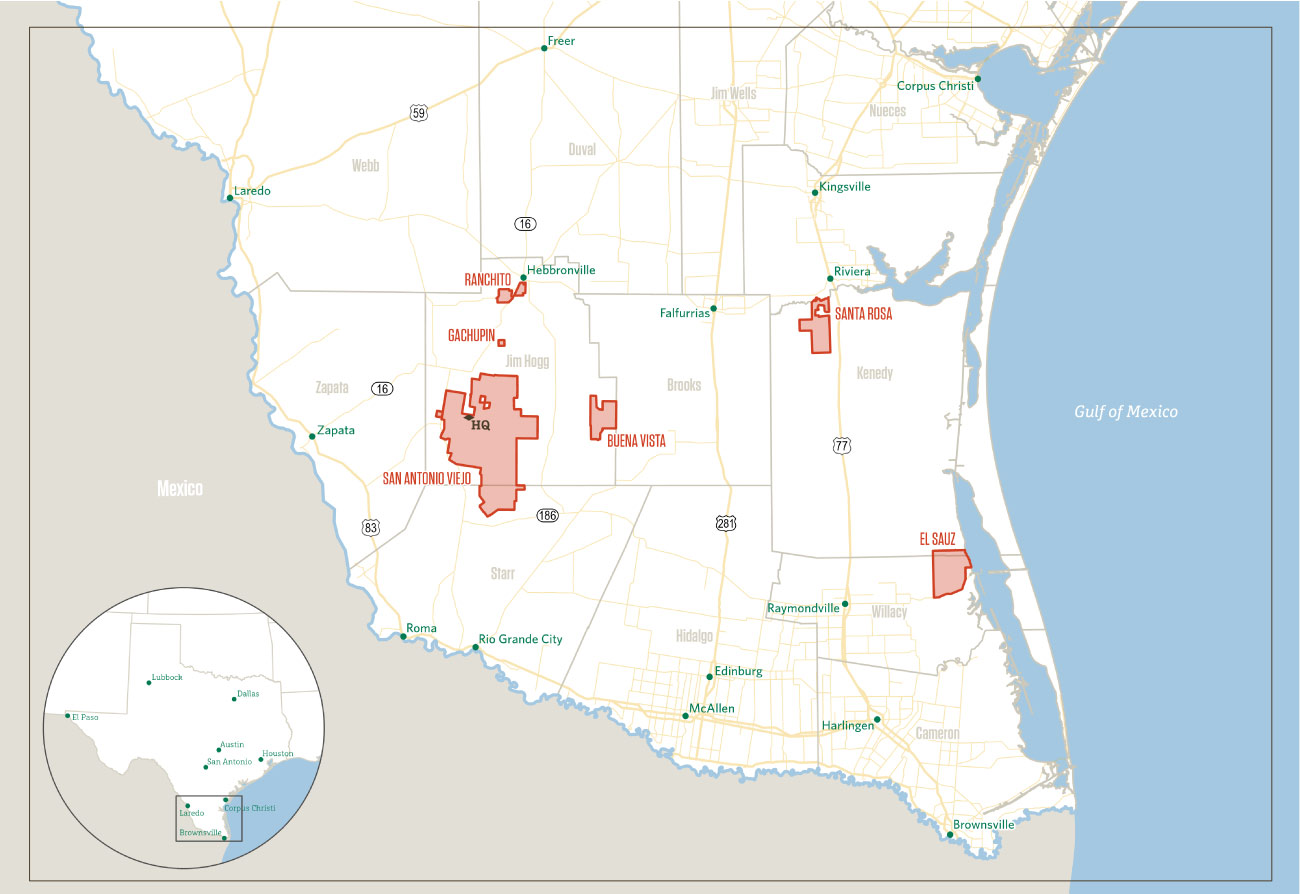Our Land
With over 217,000 acres of native rangeland, our ranches are among the largest landholdings in Texas. They span parts of Jim Hogg, Kenedy, Starr, and Willacy counties.
East Foundation RANCHES
We own six ranches in Jim Hogg, Kenedy, Starr, and Willacy counties. Our headquarters is the historic San Antonio Viejo ranch in southern Jim Hogg and northern Starr counties.
Beginning over one hundred years ago, the East family acquired ranches throughout a part of South Texas once known as the Wild Horse Desert. They held and managed these native rangelands as working cattle ranches, and we continue this legacy.
East Foundation maintains these ranches for the purpose of research that enables effective decision-making by stewards of working lands and ranch management that maximizes the long-term value of a South Texas ranch. These are working lands where scientists and managers collaborate to address issues important to wildlife management, rangeland health, and ranch productivity.
Locations
Six Ranches
We operate across a diverse area of the South Texas landscape. From San Antonio Viejo, consisting of two major ecoregions: the Tamaulipan Thornscrub and the Coastal Sand Plain, to El Sauz, which intersects the sub-ecoregions of the lower Rio Grande Valley and Laguna Madre Barrier Islands and Coastal Marshes, our land is home to abundant and diverse flora and fauna that inhabit these largely untouched far South Texas regions.
01
San Antonio Viejo
San Antonio Viejo is 150,121 acres (comparable to the size of Chicago) and encompasses two ecological regions: the Coastal Sand Plain and Tamaulipan Thornscrub. Key features include 410 miles of fence, 140 wells, and 105 miles of road. The diverse wildlife population consists of 12 small mammal species, 130 bird species, and 35 reptile and amphibian species. Management practices involve moderate grazing, prescribed fire, and chemical and mechanical brush management.
02
El Sauz
El Sauz is 27,143 acres and encompasses four ecoregions: Coastal Sand Plain, Laguna Madre Barrier Islands, Coastal Marshes, and Lower Rio Grande Valley. Its diverse landscape features rolling sand dunes, open water, marshes, tidal flats, and coastal grasslands. Notable wildlife includes white-tailed deer, javelinas, waterfowl, ocelots, and shorebirds. The area has a particular emphasis on prescribed fire research conducted in partnership with universities.
03
Santa Rosa
Santa Rosa is 18,643 acres and is located at the junction of the South Texas Sand Sheet and Gulf Coastal Plains. Its diverse landscape features mesquite savannahs, dense brush, oak woodlands, sandy grasslands, and lagunas. Wildlife includes resident and migratory waterfowl, as well as nilgai antelope. Management practices focus on brush control, employing techniques such as prescribed fire and chemical applications.
04
Buena Vista
Buena Vista is 15,106 acres and is situated on the eastern edge of Jim Hogg County. Its landscape is characterized by deep sandy grassland, small active dunes, and mesquite savannahs. Notable wildlife includes cattle, white-tailed deer, and bobwhite quail. Management practices involve maintaining a conservative stocking rate and conducting a quail harvest study.
05
Ranchito
Ranchito is 5,218 acres and is located at the edge of the coastal sand sheet. It supports a spring calving herd and, due to its geographical location, provides some of the best quail habitat. In terms of quail density, it ranks as one of the most productive areas for quail populations.
06
Gachupin
Gachupin is 639 acres and is strategically grazed as part of a larger cattle production system. It features a typical western sandsheet ecosystem, characterized by mixed brush and all native grasses. This composition results in a strong native habitat.

